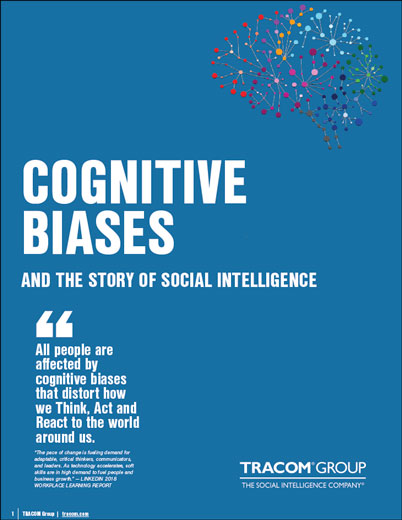Cognitive biases was a trending topic at the Association for Talent Development Conference this year—finally L&D is tuning into a deeper understanding of human mindset and behavior to overcome learning challenges. Dr. Casey Mulqueen of TRACOM, and many others at ATD, spoke on how cognitive biases can be both useful and detrimental to learning. When used properly, it can be positive for your learners.
What Are Cognitive Biases?
A cognitive bias affects how we Think, Act and React to information in the world around us. Our brains are lazy—we look for quick interpretations of events and easy solutions to problems. We develop habits so we don’t have to expend energy thinking about what we’re doing (because thinking is hard work; our brains consume approximately 20% of the body’s energy every day so habits help to save precious energy.)
For instance, in todays’ choice driven world, people tend to watch/read/follow only media which supports their beliefs. This is called the “confirmation bias” and is the primary reason people align to media with a tendency or reputation aligned to their ideals. The problem of course is that this bias can lead to excluding content that may be informative or relevant to solving issues. So while “the divided media” may appear to be a trick of political jargon, it’s also a trick of the brain based on cognitive bias. This bias and many other biases are distorting our thinking and ultimately, our success.
Why Should We Care About Cognitive Biases?
Sometimes these biases backfire, causing us to make poor choices or act in ways that don’t entirely make sense. We make mistakes and decisions unaware we are on autopilot, using shortcuts that interfere with our ability to pay attention to what’s going on around us. We like to think we are objective, logical and capable of taking in and evaluating all the information that is available. Unfortunately, these biases can trip us up, leading to poor decisions and bad judgments, which can hinder how we communicate and connect with others, respond to change and adapt to our workplace surroundings.
Understand Biases to Improve Behavior
Use knowledge about cognitive biases to your advantage — create effective learning programs by implementing the following strategies.
- Mere Ownership Effect This bias shows us that people who own something tend to value it more than people who do not own that item. Participants who “own” their training are likely to rate it as more valuable than participants who do not have a sense of ownership. When possible, advertise the program as a special privilege or event, invite teams to collaborate on training needs or specially select participants.
- Status Quo Bias This bias focuses on the human preference for things to remain the same. People are naturally reluctant to accept change, even when the change might be good for them. Be sure to include pictures and emotions, as people learn and are influenced more through vision than written or spoken words.
- Curse of Knowledge is when we have knowledge of a topic, and have a hard time remembering what it’s like to not have that knowledge. We’re in danger of presenting information ineffectively because we don’t empathize with the audience or take their point-of-view. To mitigate this bias, provide meaning, stories and spaced learning. Be concrete instead of abstract and provide specific examples.
- Planning Fallacy This bias affects us when we think that people will use what they learned, which isn’t always the case. To help prevent this, strategize beforehand using the Pre-Mortem technique. Before launching a learning program, 1) imagine that you are one year into the future, 2) imagine that the program has been a total failure, 3) individually, have everyone on your team spend a few minutes and write a brief history of what happened and 4) everyone on the team shares what they wrote. By evaluating what created a potential failure in advance, L&D leaders can enrich programs with more approaches to ongoing learning and application.
- Self-Serving Bias and the Dunning-Kruger Effect
- The Self-Serving Bias is the distortion in thinking that promotes our need to maintain and enhance self-esteem. The Dunning-Kruger Effect is the common phenomenon where unskilled people overestimate their abilities and highly skilled people underestimate their abilities. Many learning programs use assessments. Whenever these include feedback from others, it is likely you will witness these biases in action. To help alleviate this effect, educate people about these biases prior to participants receiving feedback. Explain and point out that it is simply part of the human condition.
 Social Intelligence, our ability to communicate, connect with others, innovate, and adapt easily to change, is hindered when we allow cognitive biases to negatively affect us. To develop better Social Intelligence, we need to break through these cognitive biases by changing our behavior and habits.
Social Intelligence, our ability to communicate, connect with others, innovate, and adapt easily to change, is hindered when we allow cognitive biases to negatively affect us. To develop better Social Intelligence, we need to break through these cognitive biases by changing our behavior and habits.
Download the whitepaper below, “Cognitive Biases and the Story of Social Intelligence” to see how other workplace biases get in the way of how we communicate and emotionally connect with others, innovative new thinking and adapt to change in the workplace.
Download Whitepaper

 New Horizons
New Horizons
 Project Management Academy
Project Management Academy
 Six Sigma Online
Six Sigma Online
 TCM Security
TCM Security
 TRACOM
TRACOM
 Velopi
Velopi
 Watermark Learning
Watermark Learning
 Login
Login

